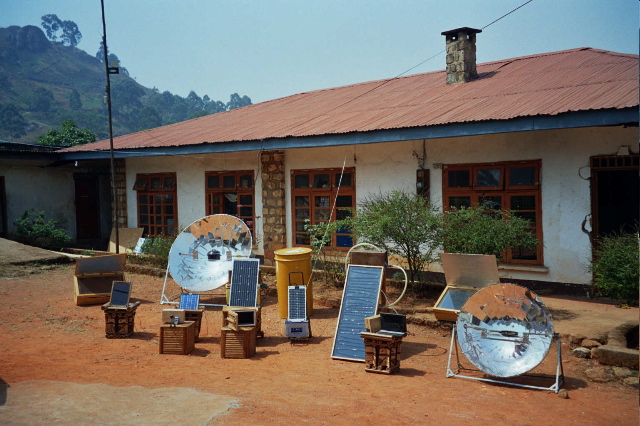The realization that better ways of doing things are a major source of economic progress has developed over many decades. Improving technology is an important means of improving productivity, and more productivity means economic growth. One might think that increasing the capital per worker, either through investing in the means of production or in human capital, is the more important way to improve productivity. However, both kinds of investments involve technological change. Moreover, the recognition that technological improvements yielding increased productivity are possible is a powerful motivation for increased savings and investment.

The original Appropriate Technology movement, triggered by E.F. Schumacher's Small is Beautiful, was based in part on the recognition that poor people in poor countries can not generate very much money for investment. Most people are poor, and if you don't improve their productivity the country and the people will remain poor. Therefore it is important to develop and disseminate technological improvements that can be used by and are affordable to the very poor. In the terms of the day, there was a need to focus on "capital saving" technologies.
Unemployment and underemployment are major problems for the poor in poor nations. If the amount of investment per worker can be held low, then the available capital could be stretched to put more workers to work. Thus, rather than labor savings technologies as were sought in rich countries with high labor costs, the original Appropriate Technology movement sought to increase the employment of labor.
It was also realized that poor people were even then destroying the environment, and technological change would therefore have to focus on promoting sustainable use of natural resources. Moreover, far too often, the poor people in developing nations were unable to maintain the new machines and devices that they obtained; the world is littered with broken machines. Often people could not obtain the financing needed to run the systems in which investments had been made. Therefore it is important to assure sustainability of technologies and technological systems serving the poor.
The original Appropriate Technology movement had a rural bias, in part because the majority of the poor people in poor countries lived in rural areas, and in part because the subsistence farm families were so poor. It also was recognized that increasing the productivity of rural labor would be necessary to contribute to overall economic development. So the Appropriate Technology movement focused heavily on agricultural technologies, cottage craft technologies, and other technologies that might be used in in rural areas.
Because of these perceptions, the original Appropriate Technology movement focused fairly strongly on machines that could be produced locally and used by the poor, such as fuel efficient cook stoves, farm machinery, construction technologies for rural housing, etc. The appropriate technology in health efforts, similarly, focused on things like oral rehydration and disposable needles that could be used in the home or by paraprofessional health workers. Indeed, the radio education efforts implemented at the same time might be seen as developing a system that could use low cost transistor radios and relatively uneducated local personnel (mothers) to provide affordable educational services, and thus closely related to appropriate technology. In all these cases it was clear that the techniques actually being used by the poor in developing countries were often very inefficient and that they could be radically improved by applying modern scientific and technical knowledge to the task.
Many participants in the original Appropriate Technology movement appeared to dismiss science based technological innovations, but of course that would be a mistake. Mobile telephones and new drugs and vaccines illustrate the importance that science based technologies can have when they are developed to meet the needs of the poor. Indeed, science based approaches can be extremely important in improving local workshop technologies in areas such as lime kilns, foundries, and brick making.
In more recent years it has been recognized that governments can best promote technological change by creating conditions where technological innovation is easy and beneficial to the innovators. The emphasis has been on the innovation system, including the availability of financial services for innovators. There has also been an emphasis on policies promoting innovation, such as those which encourage development of human resources capable of innovating technologically.
The development of institutions that facilitate technological innovation has also been recognized as important. In advanced developed nations, the intellectual focus has tended to be on institutions that promote invention and the commercialization of inventions. Note however that if one is trying to get better techniques in the hands of three or four billion poor people the emphasis is generally going to be on enhancing the diffusion of existing techniques, substituting them for less efficient techniques in use.
As one seeks better ways of doing things to improve productivity, social technologies should not be ignored. Economic and social progress can be made by better organization. Here too, however, there is a need for organizational innovations that suit the local circumstances, especially the culture of local peoples.
I would note that the spread of franchising has been an important stimulus to innovation in the United States. Large numbers of people have been able to start their own small enterprises through acquisition of a franchise from McDonnalds or any of a large number of franchisers. In the days of the original Appropriate Technology movement there were examples of franchising (milk kiosks in India, prefabricated housing factories in Colombia) but they were tangential to the central concerns and almost accidental. In areas such as health and education, institution building would be expected to focus on health and educational service organizations rather than on individual practitioners.
The geography of development is now different, in that the world population is primarily urban. Thus a new appropriate technology movement would have to focus more on technological innovation in urban areas than did the original Appropriate Technology movement. It should also be noted that many small-scale manufacturing industries are built around clusters of enterprises and workshops, often achieving synergies within a town or city neighborhood by working in the same industry. Thus one finds villages that specialize in pottery or weaving, metal working, brick making, or some other artisanal manufacture. One also finds urban areas with many related shops providing similar products.
I recommend a new appropriate technology movement that seeks to develop institutions and policies that lead to rapid innovation in the technologies used by the poor in poor nations. The emphasis would be on policies that encouraged rapid introduction of capital saving technologies enabling increased employment of the poor and sustainable use of natural resources. It would emphasize the dissemination of technologies rather than invention, and would build upon lessons learned in the original Appropriate Technology movement as well as those learned in microfinance and other development programs. However, like the original Appropriate Technology movement, it would also emphasize engineering technological improvements, emphasizing energy efficiency, affordability, labor productivity, sustainainability (both of the innovations per se and of natural resources and the environment), and tailored to local needs and cultures.
The new appropriate technology movement would differ from the science, technology and innovation programs in that it would target the technologies actually used by the poor in their work and in their lives, rather than attempting to build new science-based industries.
Often, development focuses on helping the rich in poor countries get richer. Often it focuses on external humanitarian assistance to deal quickly with hunger and disease without building the needed local capacities. The original Appropriate Technology movement focused on helping poor people to help themselves. It is time to renovate and renew that movement, building in the added knowledge we have obtained in the past decades.
Please Comment
We Need a Discussion on This Topic
We Need a Discussion on This Topic





No comments:
Post a Comment